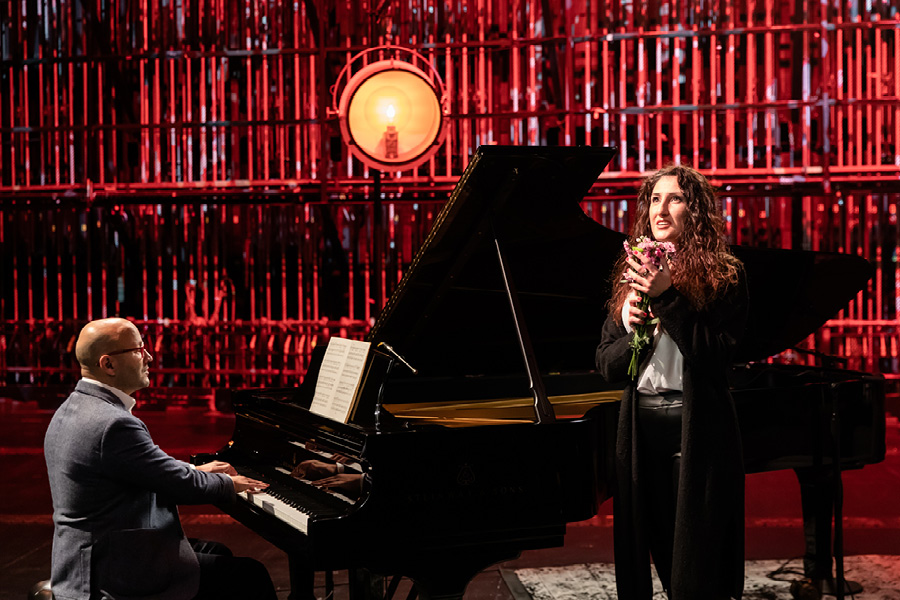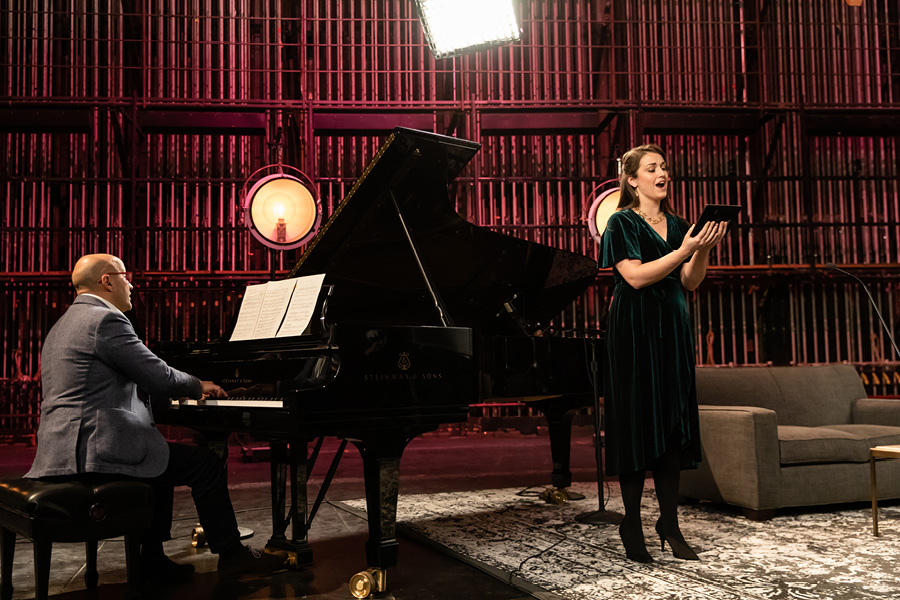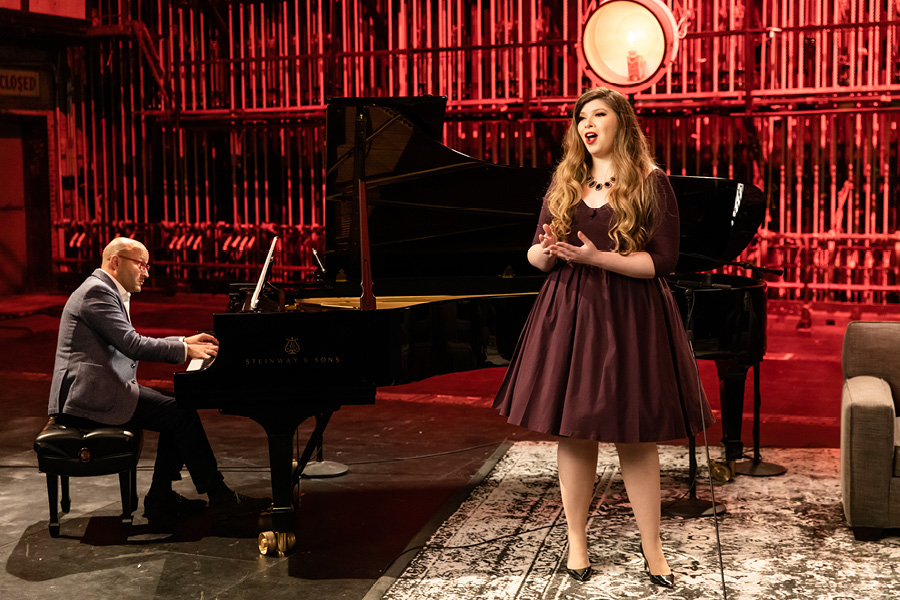May 06, 2020
Sole e Amore: The Ryan Opera Center’s Voyage of Discovery
One of the Ryan Opera Center’s most exciting new projects is Sole e Amore (Sun and Love), a streamed, semi-staged presentation of art songs by great Italian opera composers, filmed onstage at Lyric. This unfamiliar repertoire has provided exciting discoveries for all of the artists, and they’re looking forward to bringing the music to the online audience as the program premieres on Sunday, February 21st at 6:00 p.m. CST.
First-year mezzo-soprano Katherine DeYoung found it “so enriching and uplifting to do this kind of work again, safely” (Lyric is, of course, observing all the proper safety protocols). DeYoung loves this music, “which will be so much fun for the audience. You might recognize some tunes. When I was assigned a Puccini song [“Sole e Amore,” in fact], I was thrilled, especially since one of the first operas I ever saw in a professional production was La bohème at Lyric. The song ‘Sole e Amore’ uses a melody Puccini used in that opera several years later.” On the program DeYoung will also sing “Scherzo” by Respighi, “such a playful piece, and singing it felt really human.”
Music Director Designate Enrique Mazzola (who shares the piano accompaniments with Ryan Opera Center pianist Chris Reynolds) led all the musical preparation, which was intense. DeYoung enthuses, “The detailed work in coachings with Maestro Mazzola was wonderful.” First-year mezzo-soprano Katherine Beck found that “he has a really clear idea of what he wants, and he communicates it very quickly. It was so refreshing to get his ideas on these pieces.”

Mazzola carefully chose the repertoire, which includes two songs that Beck performs—Donizetti’s “Eterno amore e fè” and Verdi’s “Ave Maria.” She finds a common thread in these pieces by two very different composers: “They’re about being grounded and supported by faith and love on a human level as well as divine—your trust in God. At first I was looking at Donizetti’s song as very, very religious, but then we thought the girl might be praying for someone she’s madly in love with! I was thinking of a Romeo and Juliet sort of faith—Juliet is so excited and youthful.” One could compare this “Ave Maria” with the one Desdemona sings in Otello, “although the song was written before the opera. Growing up Catholic, I said the ‘Ave Maria’ all the time, but putting it in this context added so many layers.”
First-year soprano Maria Novella Malfatti, a native Italian, is singing Bellini’s “Per pietà, bell’idol mio” and Catalani’s “Senza baci.” The nostalgia of the Catalani song really speaks to her: “The character is singing to a love who is far from her, across the sea. I thought about my family and all the other people I love at home.” Like her colleagues, Malfatti worked hard to act her songs effectively before the camera. When Malfatti rehearsed with Mazzola and stage director Matthew Ozawa, “we talked a lot about the actress Anna Magnani—how to be expressive and show the truth to the audience, and how to be deep in your emotions with your face and your movements.”
DeYoung found that with the cameras “I had to be very cognizant of my expression.” She was thrilled that director Matthew Ozawa gave her actual stage direction (“I hadn’t been in a staging rehearsal for a year!”). Beck explains that Ozawa devised movement that was comparatively simple “because of the condensed timeline and protocols of COVID safety. It was more about intention, with little movements here and there—like sitting down or getting up off a couch—and all done on a set that was meant to be Maestro’s living room.”
Malfatti believes any viewer/listener will be excited to hear “the beautiful, simple Italian musical line. Even if they don’t speak Italian, I think the music is really clear about what it wants to say. Bellini, Puccini, and the other composers could communicate so beautifully. With them it’s almost pop music, in that it’s really understandable for the audience.”

These are the opera composers whose music will be performed in Sole e Amore:
Vincenzo Bellini (1801-1835)—11 operas, including Norma, I Capuleti e i Montecchi, I puritani, and La sonnambula.
Alfredo Catalani (1854-1893)—Six operas, only one of which, La Wally, is occasionally performed. The heroine’s aria from that opera achieved new popularity via the French thriller Diva, a much-celebrated film released in 1981.
Francesco Cilea (1866-1950)—Five operas, of which the most familiar is Adriana Lecouvreur. Composed a great deal of other vocal music.
Gaetano Donizetti (1797-1948)—More than 60 operas. Most familiar of these are the comedies The Elixir of Love, Don Pasquale, and The Daughter of the Regiment; and the romantic tragedy Lucia di Lammermoor.
Ruggero Leoncavallo (1857-1919)—20 stage works, encompassing operas and operettas; best-known work by far is the opera Pagliacci.
Pietro Mascagni (1863-1945)—15 operas, mainly on tragic subjects, such as the verismo work that made his name and for which he is best remembered, Cavalleria rusticana.
Giacomo Puccini (1858-1924)—13 operas including some of the most popular works in the entire repertoire, such as La bohème, Madama Butterfly, Tosca, and Turandot.
Ottorino Respighi (1879-1936)—12 operas, none of which are familiar today. Much more celebrated for orchestral music, including his famous “Roman trilogy” (the tone poems The Pines of Rome, The Fountains of Rome, and Roman Festivals).
Gioachino Rossini (1792-1868)—Abandoned operatic composition at the age of only 37 after composing 30 operas, including The Barber of Seville, Cinderella, The Italian Girl in Algiers, Semiramide, and William Tell.
Giuseppe Verdi (1813-1901)— His more than 25 stage works include such masterpieces as Macbeth, Rigoletto, La traviata, Il trovatore, Don Carlos, Aida, Otello, and Falstaff. Acknowledged by critics and audiences alike as the greatest master in nineteenth-century Italian opera.

Photo credit: Kyle Flubacker
